#anciennes chroniques d'angleterre
Text

guy sitting by a fire
in a manuscript of jean de wavrin's "anciennes chroniques d'angleterre", flanders, c. 1470-90
source: Paris, BnF, Français 75, fol. 198r
17K notes
·
View notes
Text
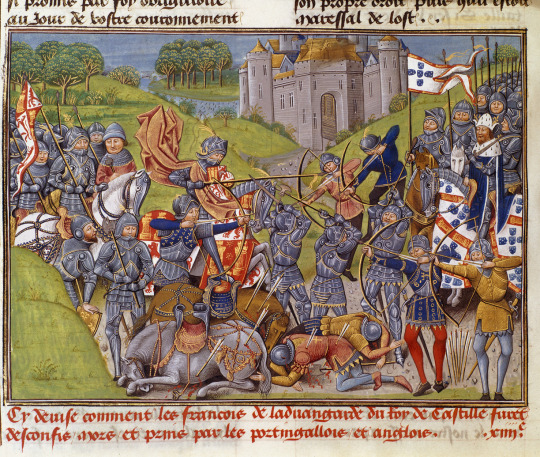
The Battle of Aljubarrota 1385
Detail from the Illuminated manuscript "Anciennes chroniques d'Angleterre" by Jean de Wavrin
#medieval#art#history#europe#european#spain#portugal#england#france#hundred years war#middle ages#knights#archers#infantry#manuscript#castilian#portuguese#english#french#castile#battle of aljubarrota#battle#bruges#miniature#jean de wavrin#illuminated manuscript#vanguard#king#armour
145 notes
·
View notes
Photo

«Those chronicles that give a date for Edward IV and Elizabeth Woodville’s marriage each specify the same one: 1 May. This date is compatible with the known movements of Edward, who was at Stony Stratford the night of 30 April 1464 and could have made an excursion to and from Grafton that morning, as claimed by Fabyan in the sixteenth century:
«[I]n most secret manner, upon the first day of May, King Edward spoused Elizabeth […] which spousals were solemnised early in the morning at a town called Grafton, near Stony Stratford; at which marriage were no persons present but the spouse, the spousess, the Duchess of Bedford her mother, the priest, two gentlewomen, and a young man to help the priest sing. After which spousals ended, he went to bed, and so tarried there three or four hours, and after departed and rode again to Stony Stratford, and came as though he had been hunting, and there went to bed again. And within a day or two after, he sent to Grafton to the Lord Rivers, father unto his wife, showing to him he would come and lodge with him a certain season, where he was received with all honour, and so tarried there by the space of four days. In which season, she nightly to his bed was brought, in so secret manner, that almost none but her mother was of counsel.»
Several historians, however, have questioned the May Day date. As David Baldwin notes, ‘The idea of a young, handsome king marrying for love on Mayday may have been borrowed from romantic tradition’. J.L. Laynesmith agreed that ‘1 May is a suspiciously apt day for a young king to marry for love. May had long been the month associated with love, possibly originating in pre-Christian celebrations of fertility and certainly celebrated in the poetry of the troubadours’.
Whether the couple were married on May Day or later, the scant record does bear out Hall’s claim that a priest was present at the wedding. A Master John Eborall, whose church of Paulspury was close to Grafton and Stony Stratford, is said to have offered in 1471 to intercede in a land dispute involving the queen ‘supposing that he might have done good in the matter, forasmuch as he was then in favour because he married King Edward and Queen Elizabeth together’. A chronicle known as Hearne’s Fragment adds that the priest who married the couple was buried at the high altar of the Minories in London, but leaves a blank space for the man’s name.”
- «The Woodvilles: The Wars of the Roses and England's Most Infamous Family» by Susan Higginbotham.
Pictured: The marriage of Edward IV and Elizabeth Woodville. Illuminated miniature from Vol 6 of the Anciennes chroniques d'Angleterre by Jean de Wavrin, 15th century.
#historyedit#edward iv#elizabeth woodville#history#15th century#the wars of the roses#wars of the roses#medieval#the middle ages#kings and queens#on this day in history#my edit
106 notes
·
View notes
Photo
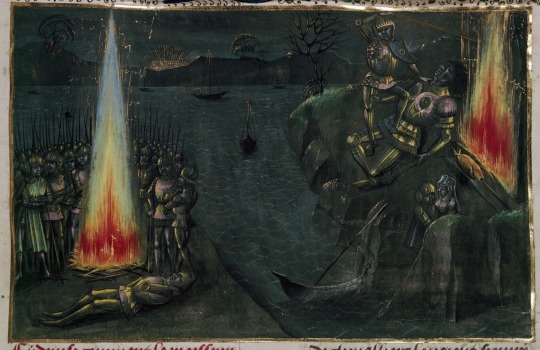
Arthur and the Spanish giant, c.1471-1483
Détail d'une miniature d'Arthur tuant le géant espagnol "mangeur de porcs" sur l'île du Mont St Michel, et sauvant Hélène, nièce de Hoël de Bretagne. Image tirée de f. 156 des Anciennes et nouvelles chroniques d'Angleterre, volume 1. Écrit en français.
5 notes
·
View notes
Text


The trusty governor Vlad Dragul and his three sons, Mircea, Vlad and Radu.
The name of Vlad is first mentioned in his father's letter of 20 January 6940 (that is, in modern parlance 1432, the document was later corrected to 1437, given the dates of other documents.
"... and not in the days of our dominion, nor in the days of my sons, the first-born Mircea and Vlad", 20 January 1432, Targoviste.
Later the governor mentioned his two sons more than once (2 August, 10 August and 23 August 1437). And a little later, in 1439, August 2, the letter will consistently mention Mircea, Vlad and Radu, indicating that Radu appeared only in 1438-39. The historian Professor Andreescu mentions that Vlad was always second in the sequence.
Duca, a 15th-century Greek historian, writes in his work that in the spring of 1442 the voivode Dragul was summoned to the court, suspecting him of conspiring with other Christians. By deceit he was forced to come (see the chronicle of Jean de Vavrin),
"In order to impress the governor with the magnanimity of a high ranking Turk, his ambassador brought with him splendid gifts and offerings as a sign of welcome, informing him who his lord was and that he saw it imperative to further his friendship and collaboration with the governor of Wallachia. And in order to achieve this, the high-ranking Turk begged the governor of Wallachia as insistently as he could to come to him in Adrianople, and in order that the governor could stay in his country in complete safety, the Subashi gave the governor a corresponding guarantee from the high-ranking Turk".
(Jean de Wavrin, Anciennes Chroniques d'Angleterre, chapter "How a High-Ranking Turk called the Ruler of Wallachia to talk to him and sneakily deposed him").
So, the Turks captured him and threw him in prison at Gallipoli.
Deceit was in the Turks' esteem, for they knew no honor and held not their word:
"But if they swear on books of soap, as it is written above, they do not perform this oath, nor any other oaths when they can; they make the innocent guilty, so that they may always carry out their malice."
"But if the Sultan makes peace or truce with anyone, he always plots its violation, and when he makes peace with one, then he wrestles with another, but he always blames his subjects, and therefore they are wicked, as if they were spinning in a wheel, so that always the Christians are oppressed, as we shall describe below, and those who ate the broth with them must pay them with meat," from the Janissary's notes, chapter "O TURKISH JUSTICE AND THEIR DEFAULTY AND Cunning".
The 15th century Turkish military historian Asık Pasha-zade (Asık Pasha-oğlu) recorded that the janitor arrived not alone but in company of his two sons who were also captured and locked up in the Eğrigöz fortress (see also Neşri's chronicle). The two sons mentioned by the 15th century historians were Vlad and the little Radu:, because the firstborn, Mircea, remained in Walachia.
Thus, the Serbian chronicles of the 15th century note that "in 1442 the Turks captured Vlad's governor, and left his son Mircea in Walachia in his place". But, as we considered earlier, most likely by the summer Hunyadi, still the voivode of Transylvania, went with an army to Walachia and drove young Mircea (14-15 years old) from the throne, bringing with him his pretender of the Daneshti family at that time, Basarab, who would already be busy signing the letters in Kurtia de Ardzesh on January 9, 1443. Duca notes that the governor Vlad regained power already in 1443, and his "young", as the historian stresses, his children will remain in captivity with the Turks. Elder son Mircea will be reunited with his father and already in 1444-45 take an active part in the Crusade:
"My father called me to him and asked for the following. My father told me, if I on behalf of him will not pay vengeance subashi from the fortress Djurdzhu, he will deny me, and I will no longer be worthy to be called his son. The reason for this is the treachery of the subashi. He brought his father to a high-ranking Turk, promising him escort
and safety, but instead he was imprisoned at Gallipoli, where he kept him prisoner in iron fetters for a long time. Now that Subashi and his Saracens are before us, surrendering to their father in return for their lives and property being spared and brought safely to Bulgaria. But I will cross the river, two leagues from here, taking two thousand Vlachs with me, and I will set a trap for them, so that the Saracens will think that they go to Nicopolis, but I will be on their way, and their death will be there", the words of Mircea, recorded from a dialogue with him by Mr. Wavrin, from the chronicle of Jean de Wavrin, chronicler of the crusade of 1444-45, Jean de Wavrin, Anciennes Chroniques d'Angleterre).
It was then that Mircea would avenge his family and the culprit who had forced his father to come to the Turks by lying was executed.
In 1445 all three sons also appear in the charter, in the same order.
#Google Translated#Vlad Tepes#history#wallachia#romania#vlad dracula tepes#article#Vlad Dracul#Mircea#Vlad#Radu
35 notes
·
View notes
Photo
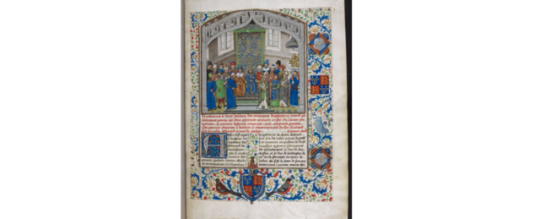
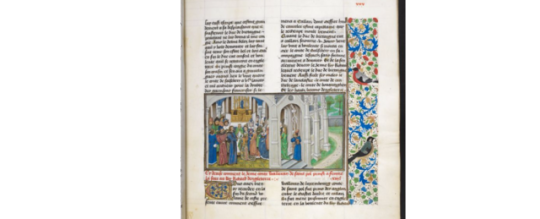
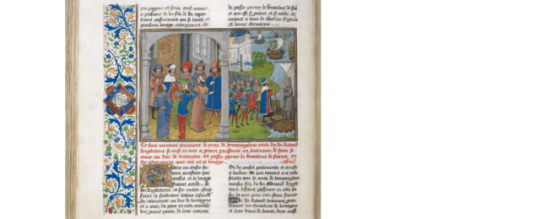
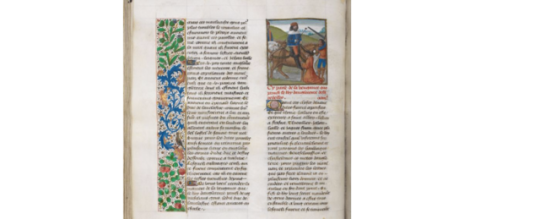

“The manuscript includes the third volume of the Anciennes et nouvelles chroniques d'Angleterre (also known as the Recueil des croniques d’Engleterre) of Jean (Jehan) de Wavrin, preceded by a list of contents (ff. 1r-9v). The text of the chronicle begins with the coronation of Richard II and ends in 1387. Incipit: 'Assez tost aprez le trespas'.
According to McKendrick (2011), the manuscript was copied by Jean Du Quesne (or Duchesne), scribe and translator from Lille and illuminated by the Master of the Vienna and Copenhagen Toison d’Or in c. 1470 (other manuscripts copied by Du Quense in the Royal collection are Royal MS 17 F I, Royal MS 17 F VI-VII, and Royal MS 16 G VIII). The work on the manuscript's decoration was subsequently completed in c. 1480 with a collaboration of the Master of the White Inscriptions (ff. 81r, 98v, 114r, 121r, 169v, 299r, see Kren and McKendrick 2003, p. 289), and the Master of Edward IV (f. 293v), with the majority of the illuminated borders painted in a style associated with the Master of the Harley Froissart, except for the three borders of the original campaign, attributable to the Master of the Vienna and Copenhagen Toison d’Or (ff. 14v, 281v, 284r).”
Taken from: http://www.bl.uk/manuscripts/FullDisplay.aspx?index=4&ref=Royal_MS_14_E_IV
The sources in order from left to right:
1- f. 10r, Richard II with his court after his coronation (book 1, chapter 1).
2- f. 39r, Marriage of Waleran, Comte de St Pol, to Maud, half-sister of Richard II (book 1, chapter 13).
3- f. 49v, Richard II and his council sending the Earl of Buckingham to Brittany, and Buckingham embarking on his ship (book 1, chapter 18).
4- f. 98v, King Richard II ordering the execution of a rebel (book 2, chapter 14)
5- f.293v. Joust between John de Holand and Regnault de Roye (book 5, chapter 41).
#King Richard II#Plantagenet#Plantagenet Dynasty#historical source#primary resource#Middle Ages#Later Middle Ages#Richard Plantagenet#John de Holand
2 notes
·
View notes
Photo

Jean de Wavrin
Anciennes et nouvelles chroniques d'Angleterre, volume 1
Netherlands, S. (Bruges)
after 1471, before 1483
French-Gothic cursive (bâtarde)
Master of the London Wavrin.
29 large miniatures in colours and gold, with full foliate borders, and initials in colours and gold, at the beginning of the prologue and other major text divisions .
Royal 15 E IV f. 287 Detail of a miniature of Edward I returning from Gascony.
0 notes
Text

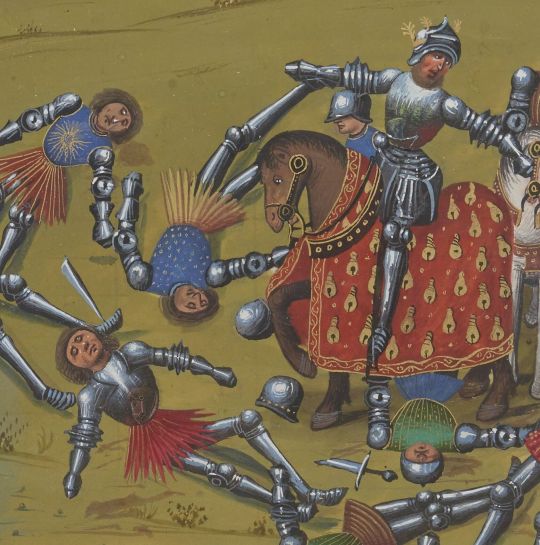
reflection of a horse on a fallen knight's armor
detail of a miniature from the "anciennes chroniques d'angleterre" (vol. 1) by jean de wavrin, flanders, c. 1470-90
source: Paris, BnF, Français 74, fol. 161v
#if you look closely you can see the reflection of the nearby trees on the mounted guy's armor :)#15th century#anciennes chroniques d'angleterre#jean de wavrin#battlefields#armor#horses#mirrors#medieval art#illuminated manuscript
317 notes
·
View notes
Text

Dracula's life from birth to 7 years by Lyzhina Svetlana Sergeevna (Лыжина Светлана Сергеевна) originally in Russian.
http://samlib.ru/l/lyzhina_s_s/dracula_7.shtml
In this article I have tried to collect ALL the information somehow related to the early childhood of Dracula, and the story of childhood always begins with the story of the birth, so that's where we'll start.
When Dracula was born.
The year of Dracula's birth is reported differently by different books. Some say 1429 and some say 1431, but all of these statements are based on the same facts.
_ _ _ _ _
Fact 1 - Dracula had an older brother, about whom we know that in 1442 he was 13-14 years old. This is reported in Jean de Wavrin's "Anciennes Chroniques d'Angleterre".
Fact 2 - Dracula first ascended the throne in November 1448 and began to rule without the help of a regent, which means that Dracula was already 17 years old at the time.
_ _ _ _ _
These two facts are the basis of all the assumptions we find in various books, so it is not difficult to guess where the numbers 1429 and 1431 come from.
If the elder brother of Dracula in 1442 was 13-14 years old, it turns out that this brother was born around 1428, which means that Dracula himself couldn't have been born before 1429.
At the same time, if you count Dracula's age from the time of his first reign, that is, subtract 17 from 1448, you get 1431. By the way, that is why the birth of Dracula is often associated with another fact - the entry of Dracula's father into the Order of St. George (Order of the Dragon).
It is presumed that the accession took place no later than January 1431, since in a letter dated February 8, 1431, drawn up in Nuremberg, Dracula's father, among other things, states that he enjoyed the support of Emperor Sigismund of Luxembourg, who was the head of the Order.
House in Sighisoara
It is common knowledge that Dracula's early childhood was spent in the Transylvanian town of Sighisoara, where our hero lived with his father, mother and older brother until the fall of 1436, which means that at the time of his departure from the "land of childhood" Dracula was no more than 7.5 years old.
How many memories could Dracula have of Sighisoara? About as many as each of us remembers of kindergarten and the first school bell. Is it a lot or not - you decide.
The house where Dracula lived is located on the corner of Zhestianshchikov Street and Museum Square. Zhestvenshchikov Street is a historical name, and Museum Square was a street in the Middle Ages and, of course, was called differently. The most likely name is Blacksmith's, so you can imagine the sounds that little Dracula heard from morning to night.
The mint in the house.
It is also known that Dracula's father set up a sort of mint in the family nest. Special people came to the house and were engaged in minting gold money - the very coins with dragons, thanks to which Dracula's father got his nickname.
The minting process and the coins themselves looked like this: https://img-fotki.yandex.ru/.../440.../0_acb55_83f50b94_orig
Of course, the presence of unauthorized people in the house and the constant hammering of the stamp caused some inconvenience to the family, but it was impossible to move the "production" to another place, because only Dracula's father had the right to mint money, and in order to comply with legal formalities, he had to do it in his own territory.
Frescoes in the house
Unfortunately, we don't know exactly what Dracula's house looked like in the 15th century. What we see now is the 17th century, but many researchers believe that the house still has something that existed in the 15th century - a mural on the wall of the second floor.
I read on the official website of House of Dracula that there were originally 4 people in the mural, although only 3 images have survived. It is believed that the "man in a turban" and the woman next to them are Dracula's parents, and to the right and left of them the artist depicted guests invited to the feast.
That the fresco depicts four people, not three, is more than
likely, but the assumption that next to the owners of the house are depicted guests, I personally think wrong, because Dracula's parents, ordering a painting, would have preferred to see there not guests, but really close people, i.e. relatives. I think the mural was a family portrait, not just a sketch from life.
The gray-bearded man on the right side of the fresco looks a lot like Dracula's maternal grandfather, the Moldovan sovereign Alexandru the Good. If I am right, the portrait on the opposite side, which is not preserved, belonged to the Romanian sovereign Mircea the Old, Dracula's paternal grandfather.
https://img-fotki.yandex.ru/.../4400.../0_acb56_233d42a_orig
By the way, there are other frescoes on the second floor, or rather remnants of frescoes. In some places we can see floral ornaments, and on the upper slopes of the windows we can see figures of some people, depicted waist-length and placed in round frames.
Most likely, the frescoes on the slopes date from the 16th century, as the numbers 1576 are visible on one of them. The only thing we can say for sure is that these frescoes depict noble people. Near one of the images there is a figure of a two-headed eagle. Next to the other image is the inscription "archi..." (Latin: archiepiscopus - archbishop). In a third image, a woman's hairstyle and a richly patterned dress are clearly visible.
https://img-fotki.yandex.ru/.../440.../0_acb57_354e446a_orig
Services in the house
Dracula's family was Orthodox, and the population of Sighisoara in the 15th century consisted almost entirely of Catholics, since at that time Transylvania did not belong to Romania, but to Hungary, a traditionally Catholic country.
There were no Orthodox churches in Sighisoara at all, and this posed a serious problem for Dracula's father and mother. Dracula's parents were supposed to live a church life, which is possible only with the participation of a priest, who can take confession, baptize the newborn, etc.
Dracula's parents lived in Hungary for many years - first at the court of Sigismund of Luxembourg, and then in Transylvania - and all this time were away from Orthodox parishes. For example, it is known that in the Middle Ages there were no Orthodox churches in the Hungarian capital. Such a temple appeared only at the end of the 15th century in the neighboring city - in Pest - and was a wooden church built by the Orthodox Serbian settlers.
How did Dracula's parents deal with the issue of confession and baptism of their children? After all, someone had to baptize the newborn Dracula as well! Most likely, the parents, being well-to-do people, hired a certain Orthodox priest, who conducted home services, took confessions, etc.
By the way, little Dracula, living in Sighisoara, is unlikely to have confessed, because in Orthodoxy all children under 7 years are considered absolutely sinless, and Dracula at the time of his move from Sighisoara to Romania was (recall) no more than 7.5 years.
Dracula's first steps in comprehension of sciences
If you believe the textbooks on the history of pedagogy, the basic principles of education since the Middle Ages have not changed so much. In the Middle Ages, as now, science was taught from the age of 7, but Dracula probably began learning a little earlier.
The Dracula researcher M. Kazaku suggests that Dracula and his elder brother had teachers in common, as the difference in the age of the brothers was insignificant - two years maximum.
If further to follow this logic, then it turns out that the older brother Dracula began to learn reading at age 7 as it should be, and Dracula was put in school at 6 or even 5 - just for the company, so that the younger brother did not hang around while the older one was sitting in class.
All the textbooks on the history of pedagogy say that in the Middle Ages the teachers of the "book sciences" were from the church milieu. Even if it was to teach a child who was not prepared for a spiritual career, he was still taught by churchmen, because they were the most literate and educated class.
By the way,
this is another argument in favor of the assumption that while Dracula's family was wandering around Catholic lands, an Orthodox priest lived there all the time. Dracula's parents needed this priest also because someone had to teach their children to read and write.
In any case, we can say with absolute certainty that the literacy learned by the young Dracula was Slavic. He simply could not have been taught Romanian literacy, because it did not exist in the 15th century.
If we look at the history of the Romanian language (old Romanian to be exact) we see that it was an oral language until the 16th century. The earliest known letter written in Romanian goes back to 1521 and is in Cyrillic script, because most of the official documents in Romania at the time were written in Slavonic and the liturgies were held in the same language. Exactly in Slavonic, not in Latin, as many people think for some reason!
This gives us reason to believe that the little Dracula, as a child of an Orthodox family, studied first of all the Slavic letters, and not the Latin.
It turns out that already at an early age Dracula knew three languages:
- Romanian, because it was spoken in the family;
- Hungarian, because the family lived in Hungarian lands;
- Slavonic, because it was the starting point for literacy.
It seems incredible that a child at such an early age could be taught a Slavic language - essentially a foreign language - but there is nothing surprising in all this. At a later time in the so-called "classical gymnasiums" young children had to learn two foreign languages at once - Greek and Latin - but no child died or went mad from this teaching. So could not the little Dracula learn the Slavic alphabet?
That is, perhaps, all there is to it, and of Dracula's further maturing one can
16 notes
·
View notes
Photo
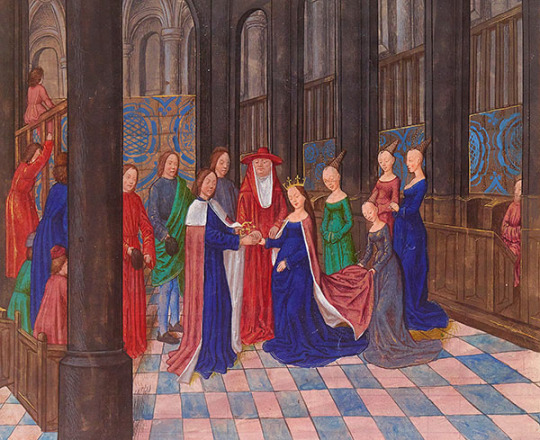
On this day in history, 1st of May 1464, Edward IV, King of England and Elizabeth Woodville married secretly at her family home in Grafton, Northamptonshire. Traditionally it was assumed to have taken place on 1 May 1464, but more recently it has been suggested that the marriage actually took place the following August. Only one source, Fabian’s Chronicle, details the wedding itself. According to Fabian, no one was present at the early-morning wedding but the spouses, Elizabeth’s mother, the priest, two gentlewomen, and a young man who helped the priest sing. “After which spousals ended, [Edward] went to bed, and so tarried there three or four hours, and after departed and rode again to Stony Stratford, and came as though he had been hunting, and there went to bed again.”
“His passion…carried him at last beyond all bounds of reason; and he offered to share his throne, as well as his heart, with the woman, whose beauty of person, and dignity of character seemed so well to entitle her to both. The marriage was privately celebrated at Grafton. The secret was carefully kept for some time: no one suspected, that so libertine a prince could sacrifice so much to a romantic passion.” - “History of England, from The Invasion of Julius Caesar to The Revolution in 1688” in 8 volumes by David Hume, esq, (1807)
Pictured: Illuminated miniature depicting the marriage of Edward IV and Elizabeth Woodville, 'Anciennes Chroniques d'Angleterre' by Jean de Wavrin, 15th century
#history#historyedit#elizabeth woodville#edward iv#on this day in history#15th century#kings and queens#edward x elizabeth#otp: edward's lovely elizabeth#my edit
176 notes
·
View notes
Photo

‘Jehan de Wavrin, Anciennes et nouvelles chroniques d'Angleterre’
King Richard II of England holding a fest with the dukes of York, Gloucester and Ireland.
[Royal MS 14 E IV]
Source: http://www.bl.uk/collection-items/miniature-of-richard-ii-dining-with-the-dukes-of-york-gloucester-and-ireland
5 notes
·
View notes